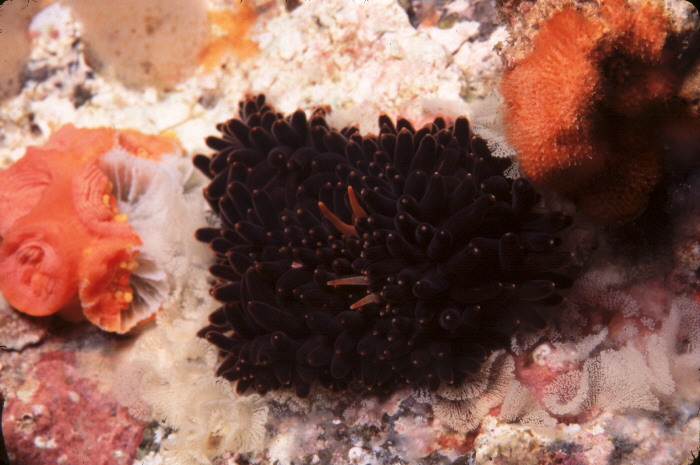 |
Phestilla melanobrachia
Photo taken by Webmaster at Divesite Mapating, Batangas, Phillipines, May 2000
Phestilla melanobrachia (Bergh, 1874)
Well, just when you think you've found the perfect example of protective resemblance - the protective color strategy many species use to elude predators while peacefully dinning on their favorite prey - along comes an example like Phestilla melanobrachia. Most of us are familiar with the variation of this species having yellow-orange cerata, making it almost invisible on its prey species, the orange cup coral, Tubastraea faulkneri. Coral Reef Animals of the Indo-Pacific, reports that the ceratal color of Phestilla is dependent on the color of the dendrophyllid coral species it is feeding on, varying from yellow to black. As shown here in Mike's photo, there is always an exception. Here is a pair of black specimens have finished dining on an orange Tubastraea, and moved on to more important activities, like procreation. You can see their freshly laid, white egg ribbon between, and below the aeolid pair and their cup coral meal.
Specimens of Phestilla most often vary in color with their coral prey species. Four very different species of these cup corals that are commonly found in areas of strong water currents, in the open, in caves, on walls and below reef overhangs, see Coral Reef Animals of the Indo-Pacific, species numbers 288-291. Another gastropod predator that feeds on this group of corals is the snail Epitomium billeanum. See Pages 72-73 of the First Edition Nubibranch and Sea Snails by Helmut Debelius for an excellent pictorial rendition of this behavior.
A member of the aeolid family Tergipedidae, Phestilla is closely related to the genus Cuthona. The primary difference between the two genera is that Phestilla lacks the sac at the tip of the cerata which store cnidarian prey stinging cells, called "nematocysts."
Phestilla melanobrachia may reach 2 cm in length, and has a wide distribution, being found from South Africa, throughout the Indo- and Western Pacific's to Japan and Hawai'i.
Mike has shared a great shot with us here. It really portrays the entire story of this species biology.
Dave Behrens
Danville, Calif
Aug. 2000
Taxonomic information courtesy of Dave Behrens

David W. Behrens
Author:
Pacific Coast Nudibranchs
Send Dave mail at seachalleng@earthlink.net
|
